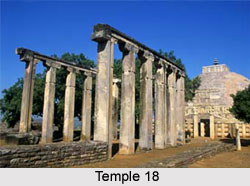 Temple 18 at Sanchi has been built on the foundations of an earlier apsidal hall of the Maurya or Sunga date. This 7th century apsidal temple originally had twelve pillars, of which nine survive; a pilaster with architraves is also still intact. Temple 18 stands on a raised platform immediately facing the South Gateway of Sanchi Stupa 1.
Temple 18 at Sanchi has been built on the foundations of an earlier apsidal hall of the Maurya or Sunga date. This 7th century apsidal temple originally had twelve pillars, of which nine survive; a pilaster with architraves is also still intact. Temple 18 stands on a raised platform immediately facing the South Gateway of Sanchi Stupa 1.
Similar on plan to the rock-cut chaitya-grihas of western India, it consists of an apse, a central nave and side-aisles. It differs, in that its apse is encompassed by a solid masonry wall instead of pillars. The 5.18 metre-high, tapering pillars are plain squares with octagonal necking, framed on either side by petals and three-fourth medallions. This is a popular pattern seen in the caves of Maharashtra. Brackets with rounded edges are over these monoliths.
Many terracotta leaf-shaped votive tablets, stamped with the figures of the Buddha, stupas and the Buddhist creed in characters of the 7th or 8th century AD, were found on the floor of the aisles on the eastern side of the apse. The chaitya-griha underwent additions in the tenth or eleventh century AD, when the floor-level of the apse was raised by means of stone-filling and richly carved door-jambs were added.
The eastern jamb, decorated with the figure of Ganga with her attendants and bands of floral motifs and human figures, is now in the Site Museum.
All vestiges of the stupa, which once stood at the centre of the apse, have now disappeared. A heap of ill-baked terracotta roof-tiles, probably belonging to the original apsidal temple, was found, along with a standard bowl made of polished Chunar sandstone of fine Maurya workmanship, at the foot of the west plinth of the temple.
This article is a stub. You can enrich by adding more information to it. Send your Write Up to content@indianetzone.com




